Plating on Molybdenum
If you are familiar with electroplating, the process of using electricity and an electrolyte solution to deposit metal ions onto the surface of another metal, then you know that specific types of metals are normally used to execute the process. These include readily available materials such as copper, zinc, tin, nickel and lead, as well as less abundant and much more valuable precious metals such as gold, silver, platinum, palladium and rhodium.
Each of these metals possess certain characteristics that make them extremely useful for a wide range of purposes including corrosion protection, electrical conductivity, increasing hardness, promoting adhesion and even enhancing the appearance of the underlying substrate. They are also relatively easy to work with; there is a vast array of time-tested methods for effectively electroplating these materials onto metals and, in some cases, plastic materials.
There is also another category of materials, known as refractory metals, which offer a number of valuable metal finishing benefits. These materials are relatively rare and pose their own unique challenges when used with processes such as electroplating, passivation and anodizing, to name a few.
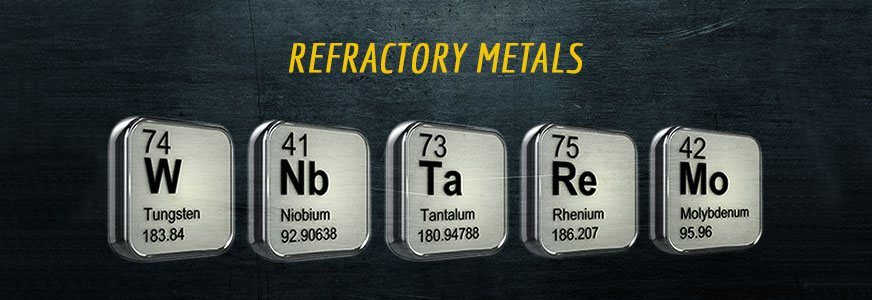
What Are the Refractory Metals?
When applied to humans, the word “refractory” means stubborn or unmanageable. When applied to a material, refractory refers to its strong ability to resist a certain process or stimulus. With regard to refractory metals, the term specifically relates to the materials’ remarkable ability to resist intense heat and wear — much more so than standard or even precious metals in many cases. This unique family of metals consists of the following five substances:
- Tungsten
- Molybdenum
- Niobium
- Tantalum
- Rhenium
Exploring the Properties of the Refractory Metals
Refractory metals share a number of properties and characteristics that are present in each of these materials to varying degrees:
- High melting point: The high melting point of refractory metals, particularly molybdenum, tungsten and tantalum, makes them extremely valuable when processing molten metals and minerals.
- Superior strength at extreme temperatures: Refractory metals, especially tungsten, offer far superior tensile strength than iron and other traditional metals.
- Remarkable corrosion resistance: Corrosion leads to the premature demise of many metal products. Electroplating with refractory metals can significantly slow down the onset of both red and white rust. In fact, tantalum is one of the most rust-resistant substances known to man.
- Strong thermal shock resistance: Thermal shock is the rapid expansion of certain parts of an object caused by intense heat. Refractory metals provide remarkable resistance to this potentially damaging condition.
- Excellent electrical conductivity: Refractory metals can give many non-conductive materials the ability to conduct electricity, making them useful in the manufacturing of electrical and electronic products and components.
- Outstanding heat resistance: Tungsten and molybdenum are frequently used as heat sinks in various electronic and mechanical devices.
- Hardness: Refractory metals can add hardness to tools made for cutting and forming steel and other metals, improving their performance and enhancing their durability.
- High density: Refractory metals are among the densest metal materials, allowing them to be used for small and large applications that require added weight — everything from golf club heads to major aircraft components.
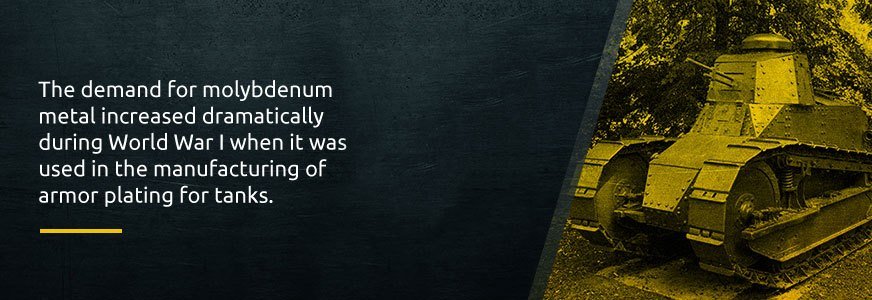
Request a free quote
For Plating with Molybdenum
Molybdenum: The Basics
There are many benefits of molybdenum electroplating. Molybdenum, chemical symbol Mo and atomic number 42, and often referred to as “moly,” is a chemical element featuring a brittle texture and a silvery-gray color that somewhat resembles lead. In fact, the word molybdenum is derived from the Ancient Greek word “molybdos,” which actually means “lead.”
Swedish pharmaceutical chemist Carl Wilhelm Scheele officially discovered Molybdenum in 1778. Three years later, a Swedish chemist named Peter Jabob Hjelm isolated molybdenum in its metallic form. However, it took another 100 years or so until molybdenum gained widespread use in industrial applications. This is largely due to the relative scarcity of molybdenum and the difficulty in extracting it from the various ores in which it is found. It wasn’t until 1906 that an American physicist and engineer named William David Coolidge filed a patent for rendering molybdenum in a ductile state, enabling it to be used as a heating element in high-temperature furnaces and other applications involving extreme heat.
The demand for molybdenum metal increased dramatically during World War I when it was used in the manufacturing of armor plating for tanks. Molybdenum served as a lightweight alternative to manganese steel plating. The molybdenum plating enabled the tanks to travel at higher speeds and increased maneuverability. It also provided excellent protection against the heavy artillery of the day.
Molybdenum Characteristics
As with all refractory metals, molybdenum features an extremely high melting point of 2623° C (4753.4° F). Only five other naturally occurring elements have a higher melting point: three of the refractory metals (rhenium, tungsten and tantalum), as well as carbon and osmium. Although molybdenum’s density is relatively high (10.22 g/cm3), it is low in comparison to other metals with high boiling points. Molybdenum also ranks the lowest of all engineering materials in terms of its coefficient for thermal expansion and exceeds only a few elements in terms of thermal conductivity.
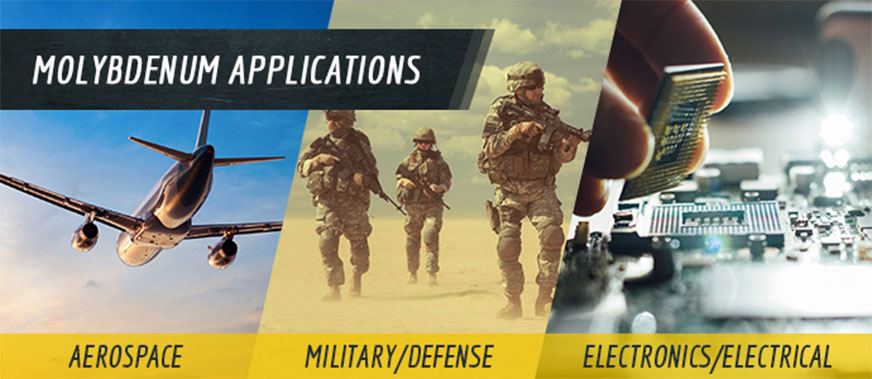
Molybdenum Applications
Perhaps molybdenum’s most valuable property from a manufacturing perspective is its ability to withstand extremely high temperatures without softening or expanding. This makes it a top choice in high-heat manufacturing applications in industries such as aerospace, military/defense, electronics/electrical and industrial motors. Because of its low density and relatively stable price point, some manufacturers choose molybdenum as a substitute for tungsten in certain applications.
Perhaps molybdenum’s most valuable property from a manufacturing perspective is its ability to withstand extremely high temperatures without softening or expanding. This makes it a top choice in high-heat manufacturing applications in industries such as aerospace, military/defense, electronics/electrical and industrial motors. Because of its low density and relatively stable price point, some manufacturers choose molybdenum as a substitute for tungsten in certain applications.
Molybdenum also offers a rare combination of toughness, weldability, hardenability and elevated temperature strength, making it a common additive in cast iron and steel manufacturing applications. When used with nickel-based alloys, molybdenum enhances corrosion resistance and high-temperature creep deformation. Because of its unique blend of properties, molybdenum and molybdenum alloys are also a popular choice in a wide range of specialized manufacturing processes that are not suitable for the use of traditional or even precious metals.
Molybdenum Electroplating
Many of the above-mentioned properties could make molybdenum extremely beneficial for metal finishing, specifically electroplating, which entails the application of a protective metal coating onto the surface of another material, which is referred to as a substrate.
The electroplating process involves filling a tank with an electrolyte solution consisting of a salt of the metal to be plated (the anode in the reaction), along with other materials such as acid. The dissolution of the salts in water results in the ionization of the metal. One end of a wire is attached to the substrate (cathode), which is immersed in the solution, while the other end is attached to the negative pole of the rectifier that provides the electricity for the process. A nickel rod is connected to another wire that is attached to the positive pole of the rectifier and immersed in the tank.
The introduction of a DC electric current provided by the rectifier causes the negatively charged substrate to attract the positively charged metal ions in the plating bath, and “electrodeposit” them onto the surface of the substrate.
The Challenge of Plating On Molybdenum
Molybdenum is highly beneficial for metal finishing and especially electroplating, which involves applying a protective metal coating onto the surface of another metal, or the substrate. However, it's more difficult to achieve success with the typical electroplating process, which involves immersion in an aqueous plating bath. The reason it's so challenging is that molybdenum has a high level of reactivity with other metals. This metal also tends to develop large and complex molecule oxides that make it harder to achieve the proper adhesion. Electroplating onto molybdenum can be done efficiently with nickel solutions, leading to a final product that will have a bright, smooth, metallic finish with a higher resistance to sulfuric acids, hydrochloric acids and strong alkalis. It will have impressive corrosion resistance too - as long as the company you work with properly executes the electroplating process.
Molybdenum Electroplating Methods
The following technique has proved effective when electroplating molybdenum in an aqueous solution for iron, nickel or carbon substrates. The process involves the formulation of an electrolyte bath containing 100 grams of potassium fluoride dihydrate, 10 cc of 48-percent aqueous hydrofluoric acid, five grams of grams of molybdic anhydride and 50 to 130 cc of water. The electric current is introduced for a period of approximately five minutes at a density ranging from 0.25 to 0.35 ampere per square centimeter of outside surface. The desired bath temperature is between 300° C and 500° C, as a higher temperature is likely to produce darker deposits and negatively impact coating adhesion.
When executed properly, this method will produce a smooth, bright metallic finish that is resistant to hydrochloric and sulfuric acids and strong alkalis. It will provide greater protection against corrosion and increase the substrate’s aesthetic appeal. It can also be used with various molybdenum alloys containing nickel, iron or cobalt.
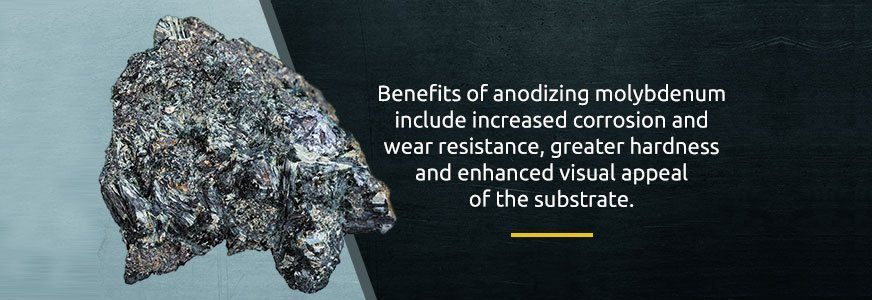
Molybdenum Anodization
While molybdenum electroplating cannot easily be accomplished with aqueous solutions using traditional plating methods, some metal finishing companies can achieve the desired outcome with anodizing. Typically used to provide a protective coating for aluminum substrates, anodization transforms a metallic surface to a ceramic state through oxidation. Benefits of anodizing molybdenum include increased corrosion and wear resistance, greater hardness and enhanced visual appeal of the substrate.
It is possible to perform successful anodization with molybdenum in alkaline, neutral, and both strong and weak acid solutions and at varied current densities. The belief is that during the anodization of molybdenum, the processes of metal dissolution, oxide formation and oxygen evolution all occur.
Molybdenum Passivation
Passivation is another alternative for applying a molybdenum coating. Passivation is a two-step post-fabrication process: the first step is pickling, which cleans the surface by removing oils and other debris. This is followed by the submersion of the substrate in a passivating bath, which deposits a thin, protective film that essentially returns the surface of the metal to its original state.
By making the surface “passive,” it becomes less reactive to environmental factors that would otherwise facilitate the onset of corrosion. Thus, passivation helps an object maintain its finish and preserve its functionality. Passivation results in the greatest level of success when coating zinc, zinc-alloy or stainless steel substrates. Passivates are also available in a wide range of colors to create a desirable appearance of the finished product.
Alternatives to Aqueous Molybdenum Plating Solutions
The inherent difficulty when plating with aqueous molybdenum baths has led to the development of a number of alternative methods. These include:
- Non-aqueous media: A primary method of depositing a coating of molybdenum using non-aqueous media is fused salt electrolysis, which involves a combination of a chemical reaction and an electron transfer using a reactor known as an electrochemical cell. An electric current passes from the anode through the electrolyte (the cell bath that must be an ionic conductor) to the cathode. The elemental components of the deposit are dissolved in molten salt and are extracted via the passage of an electrical current. The cathode element is then coated by the molybdenum compound.
- Ionic fluids: Ionic fluids are formed by the delocalization of an ionic charge that results in a reduction of lattice energy. These fluids offer many of the advantages of aqueous solutions, but with the added benefit of a much higher melting point. However, it can be extremely difficult to achieve the ideal operating conditions when using these materials. Consequently, using ionic fluids is only effective for coating a few types of metal substrates. They also tend to produce very thin coating layers, which may provide inadequate protection. In some cases, it is possible to achieve coating success by using an ionic material that melts at a lower temperature.
- Vacuum deposition: It may also be possible to deposit a coating of molybdenum onto the surface of a substrate without the use of an electrolyte bath or other liquid. One such “dry” process is vacuum deposition. There are various vacuum deposition technologies currently in use, including physical vapor deposition (PVD), PVD by vacuum evaporation, PVD by sputtering, ionic plating and several others. Vacuum-deposited metal coatings can be used to either enhance or serve as a substitute for electroplated finishes. A big disadvantage of vacuum deposition technologies is that they tend to require a more substantial equipment investment, which may ultimately result in higher prices for the manufacturers who use them.
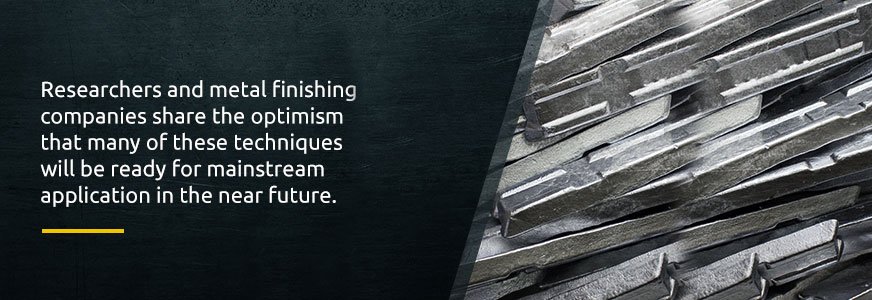
The Current State of Molybdenum Electroplating
It is necessary to point out that the most of the above-mentioned molybdenum electroplating techniques have yet to be developed to the point where they have widespread commercial application. Thus far, their use has been restricted to laboratory settings at colleges and universities and research and development facilities in government installations. However, researchers and metal finishing companies share the optimism that many of these techniques will be ready for mainstream application in the near future.
Sharretts Plating Company Intends to Be at the Forefront of Molybdenum Plating Implementation
Rest assured that when molybdenum electroplating becomes a viable commercial metal finishing process, SPC will lead the way with regard to its implementation. As a leading metal finishing innovator for more than 90 years, we have the experience and expertise to take on the many challenges of plating with molybdenum. We have a proven track record of developing cutting-edge electroplating techniques that can provide the ideal metal finishing solution for companies in a wide range of industries. We also have the capability to develop a customized plating process that is ideally suited for your specific manufacturing processes, regardless of the size of your company.
When you choose SPC for your metal finishing needs, you also work with a company that makes quality the primary focus. We’re an ISO-certified company that implements stringent quality control methods in every aspect of our organization. Our team of scientists, engineers, technicians and other professionals are all committed to one common goal: providing a cost-effective metal finishing result that helps our customers achieve their production and profitability objectives.
Additional Resources:
Contact Us for More Molybdenum Electroplating Information
Contact SPC today to learn more about the future of plating with molybdenum and how it could help you take your manufacturing operation to a higher level.
LEARN WHAT OUR MANY SATISFIED CUSTOMERS HAVE TO SAY ABOUT Us
"I would like to thank you for the help you have provided us in developing an electroless nickel plating technique on an unusual substrate. The sample platings you provided show that we should be able to reach our goals. I especially appreciate your willingness to take on an unusual job, with the uncertainties that that entails...We are looking forward to working with you in the future on our plating needs."
– Robert K.



